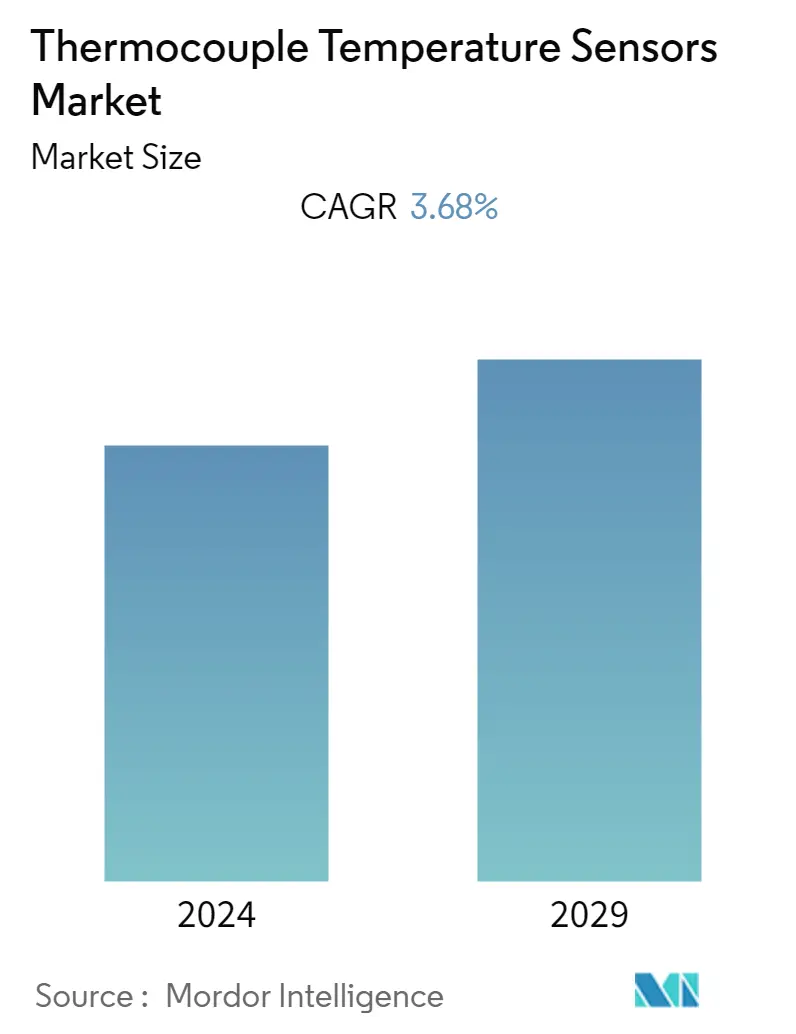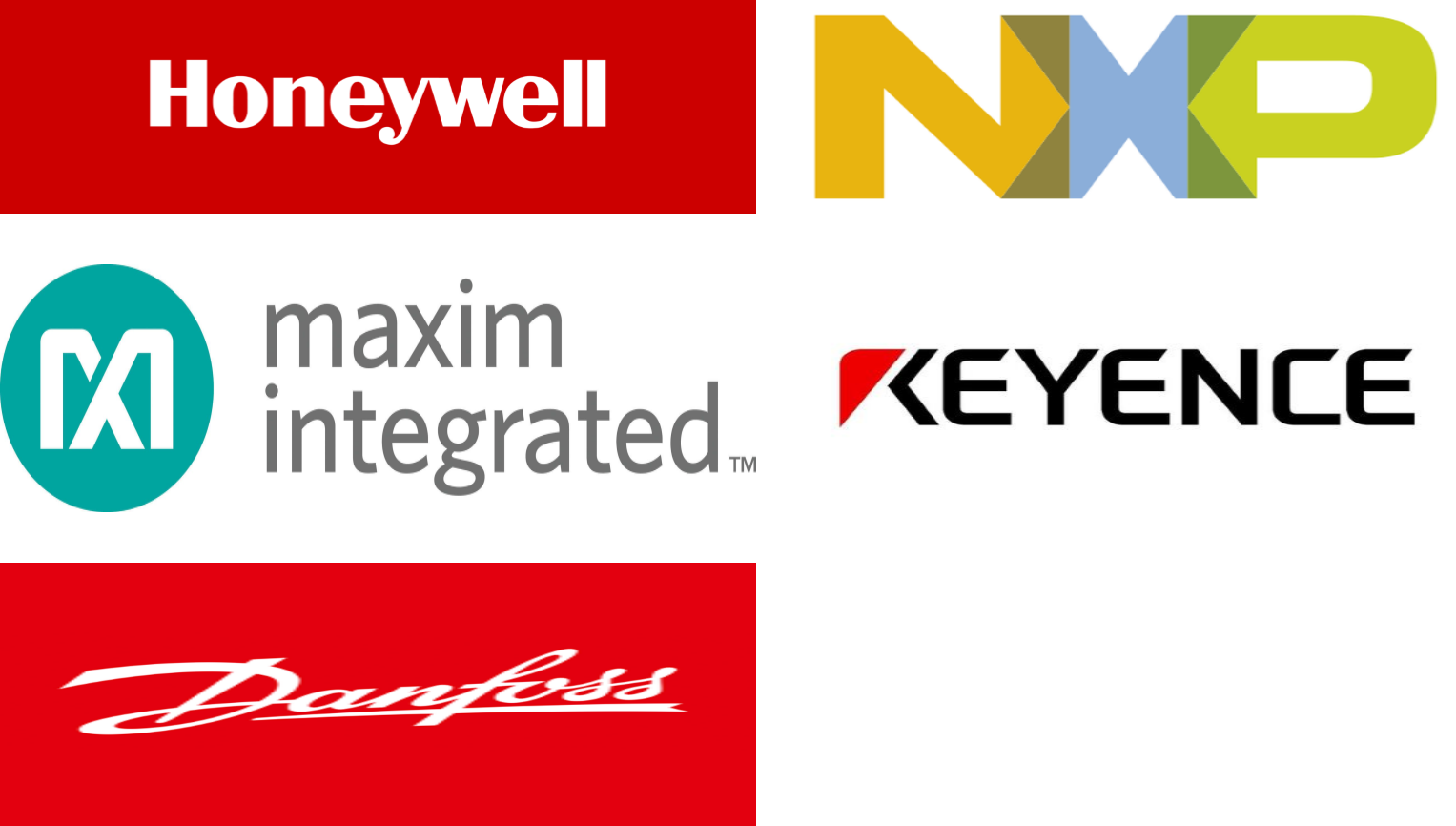Market Size of Thermocouple Temperature Sensors Industry

| Study Period | 2019 - 2029 |
| Base Year For Estimation | 2023 |
| CAGR | 3.68 % |
| Fastest Growing Market | Asia Pacific |
| Largest Market | North America |
| Market Concentration | Low |
Major Players
*Disclaimer: Major Players sorted in no particular order |
Thermocouple Temperature Sensors Market Analysis
The thermocouple temperature sensors market was valued at USD 709.89 million in 2020 and expected to reach USD 882.3 million by 2026 and grow at a CAGR of 3.68% over the forecast period (2021 - 2026). The increasingly popular trend of the development of smart cities in countries is contributing to the high growth of the electronic security market.
- Further, the introduction of advanced technologies in the global sensors market, along with the constantly growing trend of digital transformation in the industrial world, has resulted in the rising demand for sensors, especially for smart sensors.
- Thermocouple temperature sensors are mainly used for thermal management and automatic transmissions systems in the automotive industry. Therefore, the stringent emission norms for automobiles, aggressive development in an autonomous vehicle, and increasing penetration of electric vehicle (EV), globally, are some of the major factors driving the market growth. For instance, the Indian government is focusing on creating charging infrastructure and policy framework, so that by 2030, more than 30% of vehicles are electric vehicles.
- In February 2019, STMicroelectronics' entered into a partnership with Hyundai Autron, to launch a development lab for eco-friendly automotive sensor solutions. The collaboration will provide the environment for engineers to collaborate on pioneering solutions for eco-friendly vehicles, with a focus on powertrain controllers.
- However, technical awareness about sensor and heating issues in the extreme condition is the key restraints which hamper the market growth.
Thermocouple Temperature Sensors Industry Segmentation
| By Application | |
| Food and Beverage | |
| Power Generation | |
| Automotive | |
| Petrochemicals and Chemicals | |
| Oil and Gas | |
| Metals and Mining | |
| Aerospace | |
| Other Applications (Plastics, Water and Wastewater Management, Electrical, Life sciences) |
| Geography | |||||||
| |||||||
| |||||||
| |||||||
| Latin America | |||||||
| Middle East & Africa |
Thermocouple Temperature Sensors Market Size Summary
The thermocouple temperature sensors market is experiencing significant growth, driven by the increasing demand for smart sensors and the advancement of digital transformation in various industries. These sensors play a crucial role in thermal management and automatic transmission systems, particularly in the automotive sector. The push towards electric vehicles (EVs) and the development of autonomous vehicles, alongside stringent emission norms, are key factors propelling market expansion. The collaboration between companies like STMicroelectronics and Hyundai Autron to develop eco-friendly automotive sensor solutions highlights the industry's focus on innovation. However, challenges such as technical awareness regarding sensor performance in extreme conditions may hinder market growth.
The market is characterized by intense competition, with major players like Texas Instruments, STMicroelectronics, and Honeywell International actively pursuing strategic collaborations and acquisitions to enhance their market presence. The United States, with its robust automotive and aerospace industries, is expected to hold a significant share of the market. The rise in EV sales, particularly in states like California, and the competitive nature of the US aerospace sector are anticipated to drive demand for thermocouple temperature sensors. Additionally, the miniaturization of intelligent sensor technology and the integration of Automatic Temperature Control in electric vehicles present further opportunities for market growth.
Thermocouple Temperature Sensors Market Size - Table of Contents
-
1. MARKET DYNAMICS
-
1.1 Market Overview
-
1.2 Introduction to Market Drivers and Restraints
-
1.3 Market Drivers
-
1.3.1 Rising Trends of Security and Surveillance
-
1.3.2 Rapid Technological Developments
-
-
1.4 Market Restraints
-
1.4.1 Dominance of Legacy Temperature Sensor Technologies
-
-
1.5 Value Chain / Supply Chain Analysis
-
1.6 Industry Attractiveness - Porter's Five Forces Analysis
-
1.6.1 Threat of New Entrants
-
1.6.2 Bargaining Power of Buyers/Consumers
-
1.6.3 Bargaining Power of Suppliers
-
1.6.4 Threat of Substitute Products
-
1.6.5 Intensity of Competitive Rivalry
-
-
-
2. MARKET SEGMENTATION
-
2.1 By Application
-
2.1.1 Food and Beverage
-
2.1.2 Power Generation
-
2.1.3 Automotive
-
2.1.4 Petrochemicals and Chemicals
-
2.1.5 Oil and Gas
-
2.1.6 Metals and Mining
-
2.1.7 Aerospace
-
2.1.8 Other Applications (Plastics, Water and Wastewater Management, Electrical, Life sciences)
-
-
2.2 Geography
-
2.2.1 North America
-
2.2.1.1 United States
-
2.2.1.2 Canada
-
-
2.2.2 Europe
-
2.2.2.1 Germany
-
2.2.2.2 United Kingdom
-
2.2.2.3 France
-
2.2.2.4 Rest of Europe
-
-
2.2.3 Asia-Pacific
-
2.2.3.1 China
-
2.2.3.2 Japan
-
2.2.3.3 India
-
2.2.3.4 South Korea
-
2.2.3.5 Rest of Asia-Pacific
-
-
2.2.4 Latin America
-
2.2.5 Middle East & Africa
-
-
Thermocouple Temperature Sensors Market Size FAQs
What is the current Thermocouple Temperature Sensors Market size?
The Thermocouple Temperature Sensors Market is projected to register a CAGR of 3.68% during the forecast period (2024-2029)
Who are the key players in Thermocouple Temperature Sensors Market?
Maxim Integrated Inc., Keyence Corporation, NXP Semiconductors NV, Honeywell International Inc. and Danfoss Group are the major companies operating in the Thermocouple Temperature Sensors Market.

